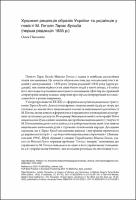Chapter Художня рецепція образів України та українців у повісті М. Гоголя Тарас Бульба (перша редакція 1835 р.)
| dc.contributor.author | Nikolenko, Olga | |
| dc.date.accessioned | 2024-04-02T15:50:53Z | |
| dc.date.available | 2024-04-02T15:50:53Z | |
| dc.date.issued | 2023 | |
| dc.identifier | ONIX_20240402_9791221502381_219 | |
| dc.identifier.issn | 2612-7679 | |
| dc.identifier.uri | https://library.oapen.org/handle/20.500.12657/89250 | |
| dc.language | Ukrainian | |
| dc.relation.ispartofseries | Biblioteca di Studi Slavistici | |
| dc.subject.classification | thema EDItEUR::D Biography, Literature and Literary studies::DS Literature: history and criticism | |
| dc.subject.other | Mykola Gogol | |
| dc.subject.other | Ukraine | |
| dc.subject.other | Cossacks | |
| dc.subject.other | image | |
| dc.subject.other | heroic epic | |
| dc.title | Chapter Художня рецепція образів України та українців у повісті М. Гоголя Тарас Бульба (перша редакція 1835 р.) | |
| dc.type | chapter | |
| oapen.abstract.otherlanguage | Artistic Reception of Images of Ukraine and Ukrainians in Mykola Gogol’s Taras Bulba (First Edition, 1835). This paper discusses Mykola Gogol’s story Taras Bulba (1835) and its exploration of Ukrainian history and culture. Gogol’s work reflects his deep study of Ukrainian and world history, as well as his collection of Ukrainian folklore. The story presents a mythopoetic image of the Ukrainian Cossack and addresses the historical context of the Zaporizhian Sich’s liquidation. Gogol aims to poetically describe the grand history of the Zaporizhian Sich and recreate the Ukrainian Cossack imagery by blending European heroic epic traditions with Ukrainian folklore. Gogol’s collections, including Evenings on a Farm Near Dikanka and Mirgorod, form a cohesive representation of his development and exploration of Ukraine’s image. The paper further highlights Gogol’s reflections on Ukrainian history and the Cossacks in his articles and emphasizes the significance of the term ‘Ukraine’ in Taras Bulba. The story portrays Ukraine as a distinct entity within European history. Gogol’s mythopoetic approach, inspired by Ukrainian songs and dumy, shapes the depiction of Ukrainian history and the passionate aspirations of the Ukrainian Cossacks. The story draws on ancient and medieval heroic epic traditions and intertwines them with domestic narratives of Taras Bulba’s family. Gogol creates images of Ukrainian Cossacks as noble knights defending their faith and ideals. Artistic Reception of Images of Ukraine and Ukrainians in Mykola Gogol’s Taras Bulba (First Edition, 1835) This paper discusses Mykola Gogol’s story Taras Bulba (1835) and its exploration of Ukrainian history and culture. Gogol’s work reflects his deep study of Ukrainian and world history, as well as his collection of Ukrainian folklore. The story presents a mythopoetic image of the Ukrainian Cossack and addresses the historical context of the Zaporizhian Sich’s liquidation. Gogol aims to poetically describe the grand history of the Zaporizhian Sich and recreate the Ukrainian Cossack imagery by blending European heroic epic traditions with Ukrainian folklore. Gogol’s collections, including Evenings on a Farm Near Dikanka and Mirgorod, form a cohesive representation of his development and exploration of Ukraine’s image. The paper further highlights Gogol’s reflections on Ukrainian history and the Cossacks in his articles and emphasizes the significance of the term ‘Ukraine’ in Taras Bulba. The story portrays Ukraine as a distinct entity within European history. Gogol’s mythopoetic approach, inspired by Ukrainian songs and dumy, shapes the depiction of Ukrainian history and the passionate aspirations of the Ukrainian Cossacks. The story draws on ancient and medieval heroic epic traditions and intertwines them with domestic narratives of Taras Bulba’s family. Gogol creates images of Ukrainian Cossacks as noble knights defending their faith and ideals. | |
| oapen.identifier.doi | 10.36253/979-12-215-0238-1.04 | |
| oapen.relation.isPublishedBy | bf65d21a-78e5-4ba2-983a-dbfa90962870 | |
| oapen.relation.isbn | 9791221502381 | |
| oapen.series.number | 55 | |
| oapen.pages | 18 | |
| oapen.place.publication | Florence |

